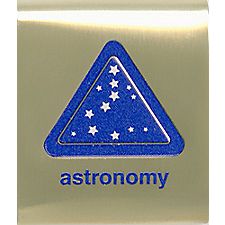This subject was added in 2002.
Requirements
Tiger Cubs, Cub Scouts, and Webelos Scouts may complete requirements in a family, den, pack, school, or community environment. Tiger Cubs must work with their parents or adult partners. Parents and partners do not earn loops or pins.
Belt Loop
Complete these three requirements:
- Set up and demonstrate how to focus a simple telescope or binoculars.
- Draw a diagram of our solar system--identify the planets and other objects.
- Explain the following terms: planet, star, solar system, galaxy, the Milky Way, black hole, red giant, white dwarf, comet, meteor, moon, asteroid, and universe.
Academics Pin
Earn the Astronomy belt loop, and complete five of the following requirements:
- Draw a diagram of a telescope and explain how it works.
- Locate and identify five constellations. You may use a telescope.
- Using a telescope, find at least one planet and identify it.
- Find the North Star. Explain its importance.
- Interview an astronomer. Learn about careers that relate to Astronomy. What school subjects will help you get a job in astronomy?
- Visit an observatory or a planetarium. Give a report on what you learned to your den.
- Make a poster illustrating the different kinds of stars. Include a diagram showing the life cycle of a star.
- Learn about some of the early space missions. Tell your den or family about one of them.
- Find a current event about a recent happening related to space. Tell your den or family about this event.
- Make a chart to show the phases of the moon over a two-month period. Define a blue moon.
- Write a report on two famous astronomers.
- Locate three major observatories on a map. Explain why these locations are good for astronomy.








